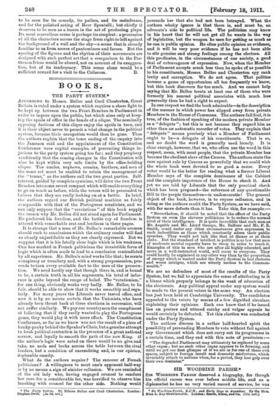THE THEATRE.
" STJMURt N " AT THE COLISEUM.
THE name of Herr Max Reinhardt is not as well known ill England as it should be. He was the first man to unite into a single Art of the Theatre the unco-ordinated efforts of the author, the scene painter, the costume designer, the actor, and the stage manager. An English visitor at the Deutsches Theater in Berlin is not merely struck by the beauty of the clothes and scenery, and by the intelligence of the acting, but he becomes conscious for the first time of an entirely new me- dium of artistic expression—for the first time he finds the whole complicated organisation of the stage concentrated upon the production of a single effect. But in each of the detailed branches of his new art Herr Reinhardt manages to secure almost perfect results. The scenery is always simple—for it must never distract the attention from the action—and as a rule its beauty depends little upon mere realism but much upon a well-directed appeal to the imagination ; the dresses are magnificent ; most striking of all, perhaps, is the elaborate effectiveness of the grouping and movements of the performers. But Herr Reinhardt has gone even further, and brought in science to help in his productions. The actual machinery of the stage has advanced ridiculously little since the seventeenth century, considering the immense progress that has been made in mechanical inventions. Herr Reinhardt's use of a revolving stage (which allows a series of elaborate scenes to be brought before the audience without an interval) and his improvements in light- ing arrangements show how mach may be gained in this direction. Indeed, it is because the Coliseum possesses what we believe is the only revolving stage in England that its enterprising manager has been able to introduce one of Herr Reinhardt's productions to the London public. Sumurein is a wordless play, with a story based partly upon one of the Arabian Nights. It is an example of all that has been said above of Herr Reinhardt's work in general. It is given here under some obvious difficulties—its length has had to be reduced by almost a half ; the Coliseum, with its gigantic proscenium, makes a distracting frame ; and, worst of all, the lighting has apparently been altered to suit our expectations of the conventionaL But, in spite of all this, SuinurtIn deserves to be seen more than any other play in London. It deserves
to be seen for its comedy, its pathos, and its 'melodrama, and for the polished acting of Herr Spontelli ; but chiefly it deserves to be seen as a lesson in the art of producing plays. Its most marvellous scene is perhaps its simplest : a procession of all the characters across the stage from right to left against the background of a wall and the sky—a scene that is already familiar to us from scores of pantomimes and farces. But the spacing of the figures and the rhythm of their movements are designed with such perfect art that a comparison to the Par- thenon frieze would be absurd, not on account of its exaggera- tion, but of its inadequacy. This scene alone would be a sufficient reward for a visit to the Coliseum. B.







































 Previous page
Previous page